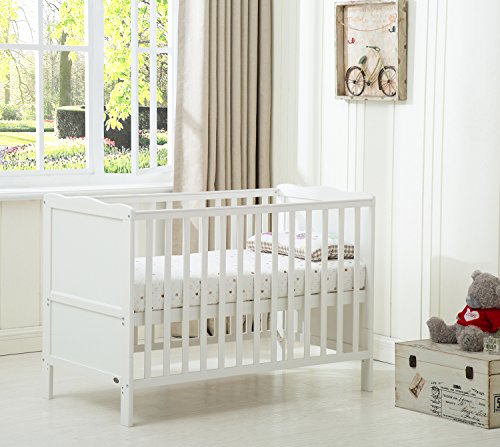8 Tips For Boosting Your White Cot Beds With Organic Materials Game

White Cot Beds with Organic Materials: An In-Depth Guide for Parents
In an age where the awareness surrounding sustainable living is on the rise, choosing organic materials for kids's furniture, particularly cot beds, has actually gathered significant attention among moms and dads. This short article offers a helpful overview of white cot beds made with organic materials, their advantages, and what to consider when selecting the right cot bed for your baby.
What Are Organic Cot Beds?
Organic cot beds are developed with the well-being of babies in mind, built from materials that are grown and processed without the use of harmful chemicals, pesticides, or synthetic ingredients. The primary focus is to create a safe and non-toxic environment for babies, whose body immune systems are more susceptible than adults.
Common Organic Materials Used in Cot Beds
- Organic Cotton: Grown without pesticides or fertilizers, organic cotton is soft and breathable. It is frequently used in mattress covers, bed linen, and specific cot structures.
- Bamboo: A sustainable resource, bamboo is naturally anti-bacterial and moisture-wicking. It is often utilized for fabrics, offering a soft touch for babies.
- Wool: Naturally hypoallergenic, organic wool assists regulate temperature and wick away moisture.
- Solid Wood: Many organic cot beds are made from sustainably sourced strong wood, such as maple or beech, which is free from toxic glues and surfaces.
- Natural Latex: Used in bed mattress, natural latex is originated from rubber trees and is resistant and supportive while remaining free of harmful chemicals.
Benefits of Choosing Organic Cot Beds
- Security for Baby: Organic cot beds are devoid of volatile organic substances (VOCs) and harmful chemicals frequently discovered in traditional furniture.
- Convenience: The breathable materials and materials utilized in organic cot beds can enhance sleep quality for babies.
- Environmental Impact: Choosing organic materials promotes sustainable agriculture and accountable forestry practices.
- Long-lasting Quality: Organic cot beds frequently include high-quality craftsmanship, translating into sturdiness and a longer lifespan.
Contrast of Organic and Conventional Cot Beds
| Feature | Organic Cot Beds | Standard Cot Beds |
|---|---|---|
| Material Safety | Non-toxic; free from chemicals | May consist of VOCs and toxic substances |
| Convenience | Breathable and hypoallergenic | Varies; might contain artificial materials |
| Ecological Impact | Sustainable and eco-friendly | Frequently non-sustainable |
| Toughness | Generally high-quality | Varies; may be less resilient |
| Rate | Usually greater | More affordable |
What to Look for When Purchasing an Organic Cot Bed
When looking for a white cot bed made from organic materials, it's vital to think about numerous factors to ensure you make an educated choice:
- Certifications: Look for certifications that guarantee organic materials, such as GOTS (Global Organic Textile Standard) for fabrics and FSC (Forest Stewardship Council) for wood.
- Mature Design: Ensure the cot bed has a fully grown design that can adapt as your child grows (e.g., switching from a cot to a toddler bed).
- Relieve of Cleaning: Babies can be unpleasant, so think about removable and washable covers for convenience.
- Safety Compliance: Check that the cot bed fulfills regional safety standards (e.g., security slats, steady building).
- Aesthetic appeals and Décor: A white cot bed can match various nursery styles, so think about designs that complement your decor.
Popular Brands Offering Organic Cot Beds
A number of brands concentrate on environmentally friendly and organic cot beds. A few of these noteworthy brand names consist of:
- Naturepedic: Known for their organic bed mattress and bed linen, they supply cot beds that concentrate on child safety and environmental sustainability.
- Kalon Studios: Offers stylish, modern cot beds made from sustainably-sourced wood.
- Silver Cross: Features traditional cot beds made from organic materials and created with security and functionality in mind.
- Babyletto: Combines contemporary design and environment-friendly practices, providing various organic and sustainable baby furnishings.
Frequently Asked Questions About Organic Cot Beds
1. Are organic cot beds more expensive than regular cot beds?Yes, organic cot beds usually come at a greater cost point due to the quality of materials and sustainable practices included in their production.
2. How do I preserve an organic cot bed?Regular cleansing with natural cleaning agents, routine vacuuming, and using protective covers can assist preserve your organic cot bed. 3. What are the signs of a poor-qualitycot bed?Signs consist of instability, a poorly finished surface
, off-gassing smells, and danger of injury due to sharp edges. 4. Can I find affordable organic cot beds?Yes, while organic cot beds can be more expensive, numerous brands provide budget-friendly options. Shopping during sales or exploring pre-owned stores can likewise be beneficial. 5. How typically must I change my baby's cot mattress?It is advised to replace the mattress every 3-5 years or when it shows indications of wear, sagging, or if the baby starts to sleep less soundly. Picking a white cot bed made from organic materials not just supports your baby's health however likewise lines up with sustainable practices that benefit the world. As mouse click the following web site look for furnishings that provides a safe and eco-friendly environment for their children, investing in organic choices emerges as a responsible option. By educating themselves on functions, materials, and brand names, moms and dads can guarantee that they are deciding that prioritizes their kid's well-being and the world's future.

